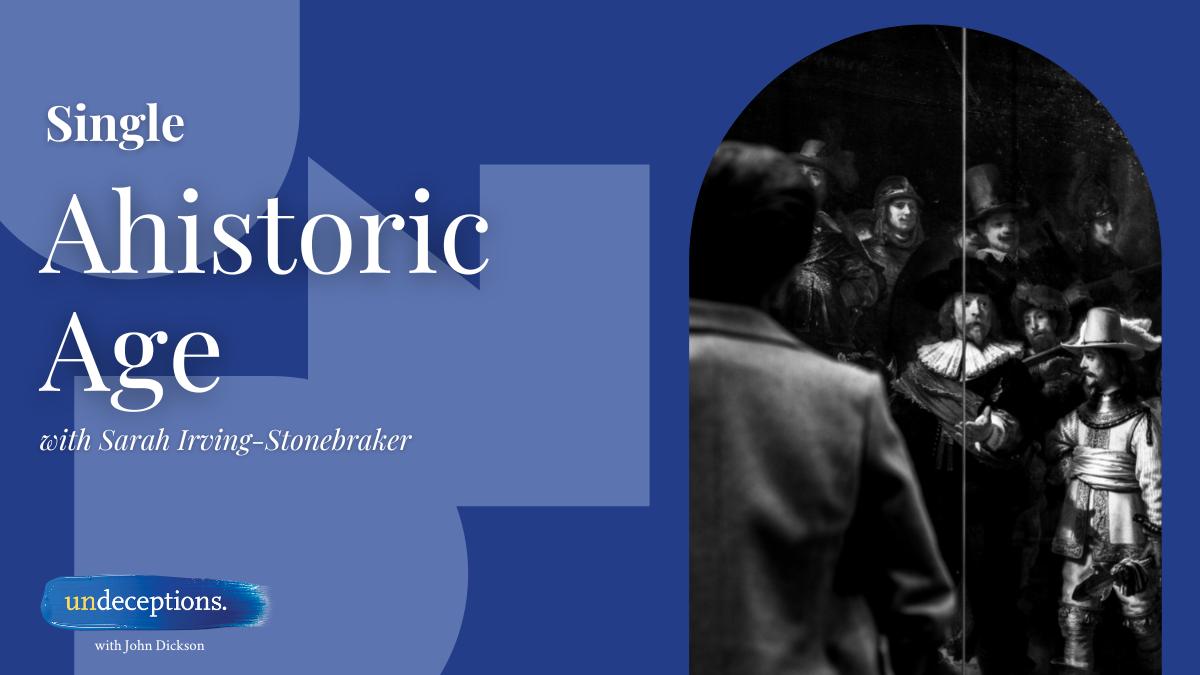By Sam Allberry (adapted by Alasdair Belling from ‘In Christ’ on the Undeceptions Podcast)
Age catches us all
I can pinpoint the exact moment I had to admit I was finally middle-aged.
I was travelling through London and needed to make a very tight connection at Paddington Station. The plan was to bound up the stairs from the underground station, glance quickly at the departures board to note the platform of my connection, and get to the train just in time to board before it left and to do all of this without having to break my stride.
In reality, I did bound up the stairs from the underground; I did glance at the departures board.
And then stopped.
I couldn’t read any of the information on the board. It was a digital display. All the. characters had a blurry halo; I could only make out the individual letters and numbers by walking right up to the board and squinting at it. For years I’d prided myself on having great eyesight. Now I knew I needed glasses.
But I still hadn’t realized just how much I needed them. When I finally got them I could see the departures board at Paddington Station clearly. But what surprised me was just how clearly I could now see everything else. It was like the whole world was in HD. I could now see distant trees and buildings in crisp detail. Everything was now more focused, and much clearer.
I had a similar experience when I started reflecting on two words that occur repeatedly in the New Testament – “In Christ”.
These words are used to describe the true reality of Christian believers. It is a doctrine theologians call “union with Christ,” the idea that when someone comes to faith in Jesus they are united to him spiritually. They are not just followers of Christ; they are in some sense now situated in him.
This, it turns out, is the New Testament’s main way to describe what we call being a Christian. One of the surprises, when we turn the pages of the New Testament, is how little the word “Christian” actually comes up. Given this is the book for Christians you’d expect it to be littered with the words “Christian” and “Christianity.”
But the word “Christian” only appears three times. One of these is referring to how the word “Christian” was initially used as a nickname for these new followers of Jesus. It was meant to be a form of mockery, the equivalent of calling them little “Christlets”. But it evidently stuck and, well, Christians have been happy to carry the label ever since.
But whereas the word Christian only comes up three times in the New Testament, the language of being “in Christ” comes up over 200 times. The Apostle Paul uses it more than 160 times alone.
Let your Bible fall open on the page of any New Testament epistle and you’ll see this kind of language, often multiple times. It’s pretty much everywhere. This is the default way of speaking of followers of Jesus. Our primary way of describing followers of Jesus is different to the New Testament. Let me give you two quick examples.
Firstly, in his second letter to the Corinthians, there’s a place where Paul needs to describe an anonymous Christian man. If we were writing this today, we’d probably say something like “I know this Christian guy”. But Paul writes, “I know a man in Christ”.
To Paul, that is the most natural and obvious way to talk about another follower of Jesus – and he’s presuming it’s the most natural and obvious way for his readers too. He doesn’t have to include a sidebar explaining what being “in Christ” means. He can just refer to “a man in Christ” and everyone knows what he’s talking about. That was the go-to terminology.
Similarly, the book of Acts describes a surge in people coming to faith “in Christ”. When people become Christians they’re not just joining some group or religious institution; they’re joining Christ himself. They’re being added to Jesus.
Here’s why this matters.
The New Testament is the founding document of Christianity. If its main language for describing followers of Jesus is different to our own, it likely means its way of understanding what it means to be a Christian is different to ours.
It isn’t just a case of “You say tomahto; I say tomayto”. If we’re seeing the Christian life differently from how the New Testament does it likely means there are things we’re missing. Which is where my new glasses come in.
When we think of someone having a relationship with Jesus, I suspect we tend to think in terms of a voter’s relationship with a political party, or a fan’s relationship with a favourite artist.
We might think in terms of following, loyalty, allegiance, and perhaps even of reverence. But the idea that we are “In Christ” suggests something far more intimate, more organic, more precious.
Jesus speaks of his people’s union with him as being like the relationship a branch has to a tree: “I am the vine and you are the branches” (John 15).
Our connection with him is vital. He is not remote, only able to inspire from across a vast distance of space and time. His very life and nourishment flow into those who are his. Spiritual health is derived from him. The Christian life is not lived only in the strength of each Christian believer. Being in Christ also speaks of intimacy. Jesus described himself as the Christ, the Son of the Father, the Savior. He also described himself as the bridegroom.
Throughout the whole Bible, God presents himself not just as a deity up in heaven, but as a divine husband to his people on earth. They in turn are not just described as his subjects but as his bride. So when Jesus announces himself as “the bridegroom” it is clear what he is claiming. Those Bible passages that speak of a believer’s relationship with Jesus in marital terms begin to come into clearer focus when we understand the idea of union with Christ.
The New Testament goes as far as to say that it is a relationship with Jesus that is the ultimate marriage, and our earthly marriages as but a shadow of this greater reality. This also makes sense of what lies at the very heart of the Christian faith — the crucifixion of Christ.
Jesus always claimed his death would be for others, on their behalf. Christians understand the cross to be a form of vicarious atonement: Jesus taking the place, bearing the sins, and enduring the punishment of sinners, and sinners, in turn, being made righteous in God’s sight.
But we might ask how it can be just for a God who, in the Old Testament condemns punishing the innocent and acquitting the guilty, to seemingly do just through Jesus’s death?
But it is this very idea of the believer is one with Jesus that makes sense of this. In a marriage, the estate of the one rightly becomes the estate of the other. So it is with Christ. He is no third party, being punished for someone else. He is the bridegroom of his people, utterly one with them, in such a way that their sins can be absorbed by him, and his righteousness shared with them. Being “in Christ” is what makes all this possible.
The cross is clearer when seen through the lens of this doctrine. In fact, everything is. Christian belief, Christian hope, the Christian community — all of it makes more sense, all of it comes into sharp focus when we realize that a Christian, first and foremost is someone who is in Christ.

Want to be further undeceived?
Check out our network of podcasts and articles in the Undeceptions Library.











































